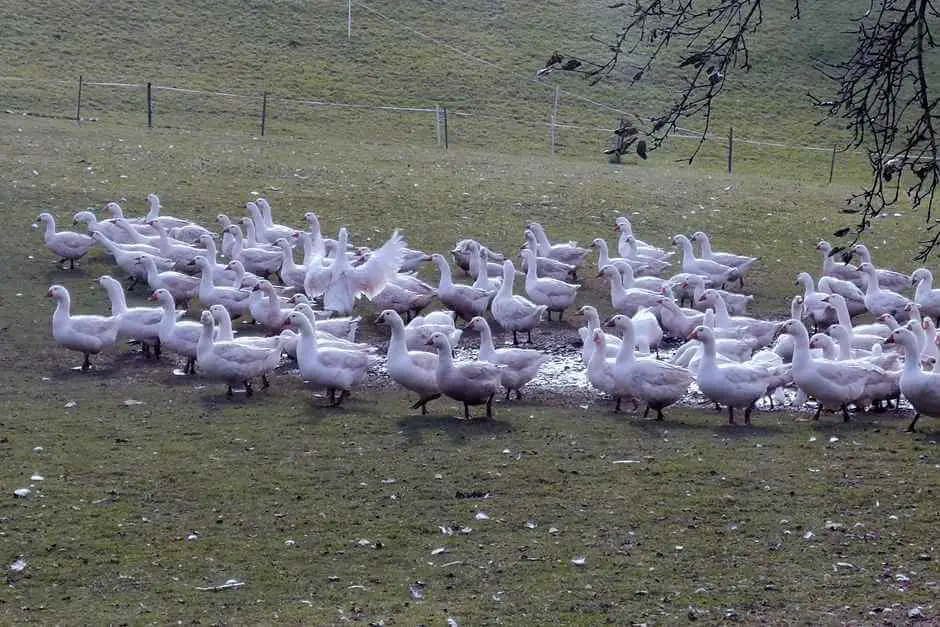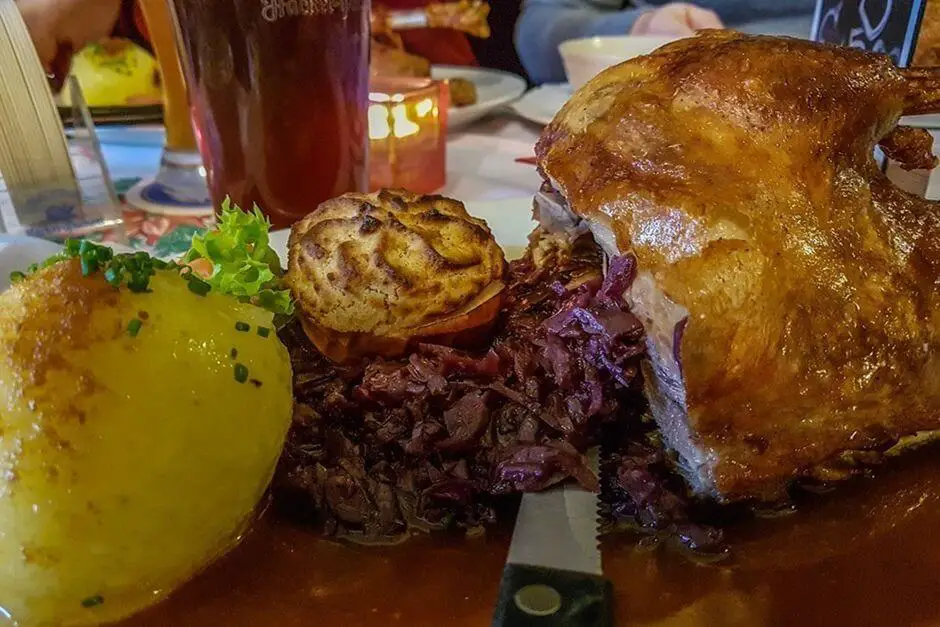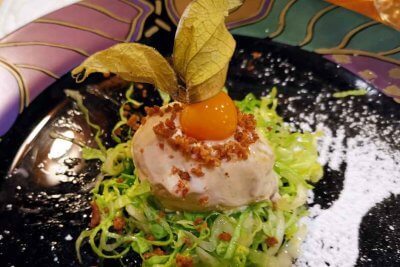Why the St. Martin's goose can taste good
The St. Martin's goose is a feast in Austria and Bavaria . November 11th is not only celebrated in the Mühlviertel as the feast of St. Martin. This feast day commemorates St. Martin of Tours. He is the founder of monasticism in the West and was the third bishop of Tours. Numerous customs are associated with his memorial day. These go back to the 19th century.

One of them is eating a St. Martin's goose on the feast day of the saint. According to legend, the saint hid in a goose pen because he considered himself unworthy to be ordained a bishop. However, the flock of goose chattered so loudly that he was found.
St. Martin's goose as a feast before Lent
Martin's Day also marks the beginning of Lent. This was celebrated in the Christian church until modern times in the weeks before Christmas. In the Orthodox Church this is still common today. St. Martin's Day fell in the time of year when geese were slaughtered that could not be fed through the winter. In addition, ingredients had to be consumed that were avoided during Lent. This included fat, lard, and eggs. So what could be better than enjoying this at a last feast before fasting with a St. Martin's goose.
In addition, Martini coincided with the end of the harvest season. The cattle were driven from the pastures into the stables. The first wine of the year could be tasted. The end of the farming year was also the day on which the tithe tax was due. In earlier times this was often paid in kind. It was not uncommon for a goose to change hands as a tax payment. So what could be more obvious than to celebrate this feast day with a St. Martin's goose?
The tradition of eating a St. Martin's goose on Martini is still alive today. It is no longer customary to fast before Christmas. However, the gourmet meal at the end of the farming year still exists today.

Grazing geese are raised in the Mühlviertel
In the hill country of the Mühlviertel in the region around Freistadt, one encounters flocks of geese on their pastures again and again. We visit Hubert Leitner. He is a farmer and breeds free-range geese. There are two hundred who perform their goose ballet in his pasture. He tells us that he lets the geese roam free in the pasture during the day from June to October. They are mostly seen in a crowd. It's safer when there is danger. In the eyes of the geese, this is often the case. It is enough that we get too close. If the distance is too small for them, the whole bunch of geese moves away from us.
“At night I drive them into the stable every evening. There they are protected and foxes cannot harm them,” explains Leitner. The animals have a lot of exercise on his pasture. "Sometimes I have to look for them," he laughs. "Then they disappear behind the hilltop and I can no longer see them." They even have a pond in which to wallow. They lead a happy goose life. Their free life does not end until the end of October. They don't spend the winter in the stable. Instead, they either end up as St. Martin's geese in the saucepans of the Mühlviertel kitchens. Or they are frozen in order to finally adorn the Christmas meal as a Christmas goose.
Enjoy a goose menu instead of a St. Martin's goose
St. Martin's goose doesn't always have to be traditional. That's what the Dorfwirt Raab in Rechberg * has shown us. You can not only stay overnight there, but also eat very well. However, you should be hungry with a six-course goose-themed menu at the Dorfwirt. What I particularly liked is how imaginatively they cooked the goose there. They even took inspiration from American chefs. There was “pulled goose” and an imaginative dessert of caramel ice cream with salad, salt and goose croutons. As exotic as it sounds, it was delicious. Our six-course goose menu from the Mühlviertler pasture goose consisted of these courses:
-
Homemade Ravioli
These were filled with goose meat, blackberry spruce, root vegetables, leek on red cabbage with a parmesan spruce chip.
-
Goose pickled Soup
with bread chips
-
Pulled Goose
pulled goose, red cabbage, rocket, pear, cranberries, pancakes
-
Glazed Goose Liver
with saffron apple, dirndl (cherry) jam and bread dumplings
-
Breast of the Goose
Glazed with honey and garlic, creamed sausage and Bohemian dumplings
-
Freak out Goose
salted caramel ice cream, goose skin chip on a bed of lettuce with lemon vinaigrette
There was wine for every course Wine competence center made of perg, which wonderfully emphasized the respective flavors of the food. Mühlviertel wines go perfectly with a hearty meal like this one. So why not enjoy the St. Martin's goose in an extraordinary way? We loved this meal. Further Guesthouses in the Mühlviertel you can discover here.
After we got one a few years ago Shopping tour for the goose through Burgenland we are shown in the pleasure region of Weidegans in the Mühlviertel how exciting these ingredients can be combined into a menu.

This is how you prepare a St. Martin's Goose yourself
This year we won't have a goose dinner in the restaurant on November 11.11th. Instead, we prepare a roast goose at home. This recipe makes it particularly tender. But be careful! You need a lot of time for this type of preparation. For this you need the following
Ingredients:
- one free-range goose (preferably directly from the farmer)
- two onions
- soup vegetables
- half a liter of white wine
- 300 - 400 ml vegetable stock
- a handful of fresh marjoram
- 5 bay leaves
- 6 juniper berries
- 3 cloves
- 50 grams of butter
- 5 tbsp olive oil
- Salt, pepper from the mill
- 1 sip of calvados
For the filling:
- three apples
- two onions
- two to three tablespoons of raisins
Preparation of the St. Martin's goose:
Remove the giblets and wash the goose thoroughly on the outside and inside. Then season the goose inside and outside with salt and pepper. We like to fill the St. Martin's goose with apples, onions and raisins.
Brush a roasting pan with olive oil and place the goose in it. Then you roast the goose at 230 degrees Celsius for half an hour.
Now you need patience. To make the roast goose particularly tender, you now switch the temperature back to 70 degrees Celsius. The St. Martin's goose must stay in the oven at this temperature for about eighteen hours. Then you take it out of the oven and heat it up to 200 degrees. Put the goose in the oven for another 30 minutes and baste the gravy every few minutes. This is how it gets its crispy crust.
The long roasting time makes the St. Martin's goose particularly tender.
How to make the sauce for the St. Martin's goose:
To do this, fry the innards in oil together with the cleaned and diced soup vegetables. Then you add marjoram, juniper berries, cloves and bay leaves and roast them briefly. Add some wine and let it boil down. Then you pour in the rest of the wine and fill up with broth until everything is covered. Let this simmer at low temperature until the goose is ready to serve. We like to add a shot of calvados. This ensures a good taste. Let the sauce reduce until it has the desired consistency. Stir in cold butter with the whisk and add some of the gravy from the roaster if you like.
How and where you ultimately eat or prepare your St. Martin's goose is up to you. With these tips you are definitely well prepared for it. We wish a good appetite!

Do you already know
- can Mühlviertler Wasp nests?
- Upper Austria travel destinations
- Freistadt Austria Restaurants with a twist
- Mostviertel Austria
Quelle How the St. Martin's goose tastes good: research on site. For the recipe we got from Cooking makes you happy get inspired.
Text: © Monika Fuchs, TravelWorldOnline
Photos: © Copyright Monika Fuchs, TravelWorldOnline





